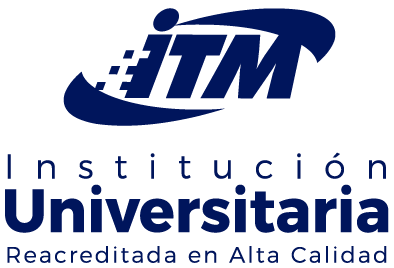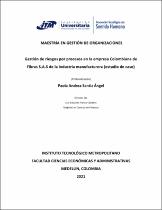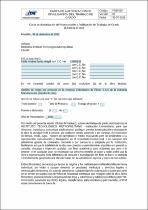Mostrar el registro sencillo del ítem
Gestión de riesgo por procesos en la empresa Colombiana de Fibras S.A.S de la Industria Manufacturera (estudio de caso)
| dc.contributor.advisor | Franco Ceballos, Luis Eduardo | |
| dc.contributor.author | Santiz Ángel, Paola Andrea | |
| dc.date.accessioned | 2023-02-23T20:28:46Z | |
| dc.date.available | 2023-02-23T20:28:46Z | |
| dc.date.issued | 2022 | |
| dc.identifier.uri | http://hdl.handle.net/20.500.12622/5839 | |
| dc.description.abstract | Culturalmente la gestión del riesgo debe ser una disciplina en cualquier empresa u organización, pero no es así. En la empresa Colombiana de Fibras S.A.S. Existe una gran resistencia a la gestión del riesgo en sus procesos. Dicha situación es incitada por el desconocimiento y la falta de cultura acerca de cómo debe emplearse o abordarse dicha gestión. Para promover un cambio en la organización, es necesario gestionar los riesgos en los procesos y para ello se implementan las normas más modernas relacionadas con la gestión de la calidad en los procesos, lo que integrado con alternativas financieras y económicas para la identificación y medición de los riesgos asociados, contribuye a cuantificar los riesgos de forma individual y global, permitiendo proponer acciones de intervención que ayuden a mitigar los efectos adversos y potencializar la sostenibilidad de la empresa en un entorno económico cada vez más dinámico, turbulento, globalizado e incierto. Para la identificación de los riesgos, en este trabajo se procede a aplicar por primera vez para la empresa, una caracterización detallada en cada de uno de sus ocho procesos, siguiendo la estructura del ciclo PHVA de la norma ISO 9001:2015. El aporte de la implementación de esta metodología es que permite la incorporación de la gestión del riesgo o el enfoque basado en riesgos, en los Sistemas de Gestión de la Calidad, contribuyendo con la identificación de los riesgos, así como también contribuye a identificar la interacción entre los procesos. Sumado a lo anterior, para la identificación detallada de los riesgos, se recurre a entrevistas con cada uno de los responsables de los procesos, lográndose identificar 35 riesgos asociados a los procesos de la empresa. Luego, para determinar el impacto económico esperado de cada uno de los riesgos identificados previamente, se recurre al criterio de los expertos y líderes de los procesos (Gerente General, Jefe de compras e inventarios, Contador, Revisor Fiscal, y Coordinador de Producción), quienes apoyados en su experiencia, los registros históricos de la compañía, la información contable y financiera, y con la ayuda del Software administrativo llamado My process, ayudan a identificar las pérdidas esperadas por la posible materialización de cada riesgo, así como sus probabilidades asociadas en escenarios con consecuencias bajas, moderadas, altas y extremas. Posteriormente, se hace una adaptación de la teoría de portafolios para realizar el cálculo de las pérdidas esperadas globales para la compañía y su riesgo agregado. Esta aproximación y adaptación de la teoría de portafolios para cuantificar el riesgo de los procesos de la empresa, es también un aporte original de este trabajo y en la búsqueda bibliográfica no fue identificada en ningún estudio previo. Desde la aparición de la crisis sanitaria mundial producida por el Covid19, en la empresa ha crecido el interés por contar con aproximaciones para valorar los riesgos individuales y grupales asociados a los procesos. La metodología desarrollada en el presente trabajo es replicable en organizaciones que identifiquen los riesgos en sus procesos. Además, los resultados obtenidos del cálculo de los valores ayudan para la cuantificación de las pérdidas, permitiendo una medición cuyo análisis contribuye a generar acciones de intervención ante situaciones adversas que se pueden ocasionar por una posible materialización de los riesgos. Además, los resultados generados en esta investigación corresponden a una aproximación de medición que contribuye a proponer algunas acciones de intervención para la empresa. Finalmente, se plantean conclusiones, recomendaciones y posibles alternativas para trabajos futuros. | spa |
| dc.format.mimetype | application/pdf | |
| dc.language.iso | spa | spa |
| dc.rights.uri | http://creativecommons.org/licenses/by-nc-nd/4.0/ | * |
| dc.subject | Calidad, procesos, gestión, riesgos, manufactura, impacto económico, pérdidas esperadas. | spa |
| dc.title | Gestión de riesgo por procesos en la empresa Colombiana de Fibras S.A.S de la Industria Manufacturera (estudio de caso) | spa |
| dc.publisher.faculty | Facultad de Ciencias Económicas y Administrativas | spa |
| dc.subject.keywords | quality, processes, management, risks, manufacturing, economic impact, expected losses. | spa |
| dc.subject.lemb | Riesgos laborales | spa |
| dc.subject.lemb | Salud laboral | spa |
| dc.subject.lemb | Salud ocupacional | spa |
| dc.subject.lemb | Seguridad industrial | spa |
| dc.subject.lemb | Responsabilidad patronal | spa |
| dc.subject.lemb | Ambiente de trabajo | spa |
| dc.description.abstractenglish | Culturally, risk management should be a discipline in any company or organization, but it is not. In the Colombian company of Fibras S.A.S. There is great resistance to risk management in its processes. This situation is prompted by ignorance and lack of culture about how such management should be used or addressed. To promote a change in the organization, it is necessary to manage the risks in the processes and for this the most modern standards related to quality management in the processes are implemented, which is integrated with financial and economic alternatives for the identification and measurement of risks. associated risks, contributes to quantifying risks individually and globally, allowing intervention actions to be proposed that help mitigate adverse effects and enhance the company's sustainability in an increasingly dynamic, turbulent, globalized and uncertain economic environment. For the identification of risks, in this work we proceed to apply for the first time for the company, a detailed characterization in each of its eight processes, following the structure of the PDCA cycle (Plan, Do, Check, Act) of the ISO 9001: 2015 standard. The contribution of the implementation of this methodology is that it allows the incorporation of risk management or the risk-based approach, in the Quality Management Systems, contributing to the identification of risks, as well as helping to identify the interaction between the processes. In addition to the above, for the detailed identification of the risks, interviews are used with each one of those responsible for the processes, being able to identify 35 risks associated with the company's processes. Then, to determine the expected economic impact of each of the previously identified risks, the criteria of the experts and leaders of the processes (General Manager, Head of Purchasing and Inventories, Accountant, Statutory Auditor, and Production Coordinator) are used. who, supported by their experience, the historical records of the company, the accounting and financial information, and with the help Culturally, risk management should be a discipline in any company or organization, but it is not. In the Colombian company of Fibras S.A.S. There is great resistance to risk management in its processes. This situation is prompted by ignorance and lack of culture about how such management should be used or addressed. To promote a change in the organization, it is necessary to manage the risks in the processes and for this the most modern standards related to quality management in the processes are implemented, which is integrated with financial and economic alternatives for the identification and measurement of risks. associated risks, contributes to quantifying risks individually and globally, allowing intervention actions to be proposed that help mitigate adverse effects and enhance the company's sustainability in an increasingly dynamic, turbulent, globalized and uncertain economic environment. For the identification of risks, in this work we proceed to apply for the first time for the company, a detailed characterization in each of its eight processes, following the structure of the PDCA cycle (Plan, Do, Check, Act) of the ISO 9001: 2015 standard. The contribution of the implementation of this methodology is that it allows the incorporation of risk management or the risk-based approach, in the Quality Management Systems, contributing to the identification of risks, as well as helping to identify the interaction between the processes. In addition to the above, for the detailed identification of the risks, interviews are used with each one of those responsible for the processes, being able to identify 35 risks associated with the company's processes. Then, to determine the expected economic impact of each of the previously identified risks, the criteria of the experts and leaders of the processes (General Manager, Head of Purchasing and Inventories, Accountant, Statutory Auditor, and Production Coordinator) are used. who, supported by their experience, the historical records of the company, the accounting and financial information, and with the helpCulturally, risk management should be a discipline in any company or organization, but it is not. In the Colombian company of Fibras S.A.S. There is great resistance to risk management in its processes. This situation is prompted by ignorance and lack of culture about how such management should be used or addressed. To promote a change in the organization, it is necessary to manage the risks in the processes and for this the most modern standards related to quality management in the processes are implemented, which is integrated with financial and economic alternatives for the identification and measurement of risks. associated risks, contributes to quantifying risks individually and globally, allowing intervention actions to be proposed that help mitigate adverse effects and enhance the company's sustainability in an increasingly dynamic, turbulent, globalized and uncertain economic environment. For the identification of risks, in this work we proceed to apply for the first time for the company, a detailed characterization in each of its eight processes, following the structure of the PDCA cycle (Plan, Do, Check, Act) of the ISO 9001: 2015 standard. The contribution of the implementation of this methodology is that it allows the incorporation of risk management or the risk-based approach, in the Quality Management Systems, contributing to the identification of risks, as well as helping to identify the interaction between the processes. In addition to the above, for the detailed identification of the risks, interviews are used with each one of those responsible for the processes, being able to identify 35 risks associated with the company's processes. Then, to determine the expected economic impact of each of the previously identified risks, the criteria of the experts and leaders of the processes (General Manager, Head of Purchasing and Inventories, Accountant, Statutory Auditor, and Production Coordinator) are used. who, supported by their experience, the historical records of the company, the accounting and financial information, and with the help of the administrative software called My process, help to identify the expected losses due to the possible materialization of each risk, as well as their associated probabilities in scenarios with low, moderate, high and extreme consequences. Subsequently, an adaptation of the portfolio theory is made to calculate the global expected losses for the company and its aggregate risk. This approach and adaptation of the portfolio theory to quantify the risk of the company's processes is also an original contribution of this work and in the bibliographic search it was not identified in any previous study. Since the appearance of the global health crisis caused by Covid19, the company has grown interested in having approaches to assess the individual and group risks associated with the processes. The methodology developed in this work is replicable in organizations that identify the risks in their processes. In addition, the results obtained from the calculation of the values help to quantify the losses, allowing a measurement whose analysis contributes to generating intervention actions in the face of adverse situations that may be caused by a possible materialization of the risks. In addition, the results generated in this research correspond to a measurement approach that contributes to proposing some intervention actions for the company. Finally, conclusions, recommendations and possible alternatives for future work are proposed. | spa |
| dc.description.degreename | Magíster en Gestión de Organizaciones | spa |
| dc.identifier.instname | instname:Instituto Tecnológico Metropolitano | spa |
| dc.identifier.reponame | reponame:Repositorio Institucional Instituto Tecnológico Metropolitano | spa |
| dc.identifier.repourl | repourl:https://repositorio.itm.edu.co/ | |
| dc.rights.local | Acceso abierto | spa |
| dc.rights.accessrights | info:eu-repo/semantics/openAccess | |
| dc.rights.creativecommons | Attribution-NonCommercial-NoDerivatives 4.0 International | * |
| dc.type.local | Tesis de maestría | spa |
| dc.type.coar | http://purl.org/coar/resource_type/c_bdcc | spa |
| dc.type.driver | info:eu-repo/semantics/masterThesis | spa |
| dc.publisher.grantor | Instituto Tecnológico Metropolitano | spa |
| dc.description.degreelevel | maestría | spa |




